light MAZDA MODEL MX-30 EV 2022 Owner's Manual
[x] Cancel search | Manufacturer: MAZDA, Model Year: 2022, Model line: MODEL MX-30 EV, Model: MAZDA MODEL MX-30 EV 2022Pages: 547, PDF Size: 79.35 MB
Page 62 of 547
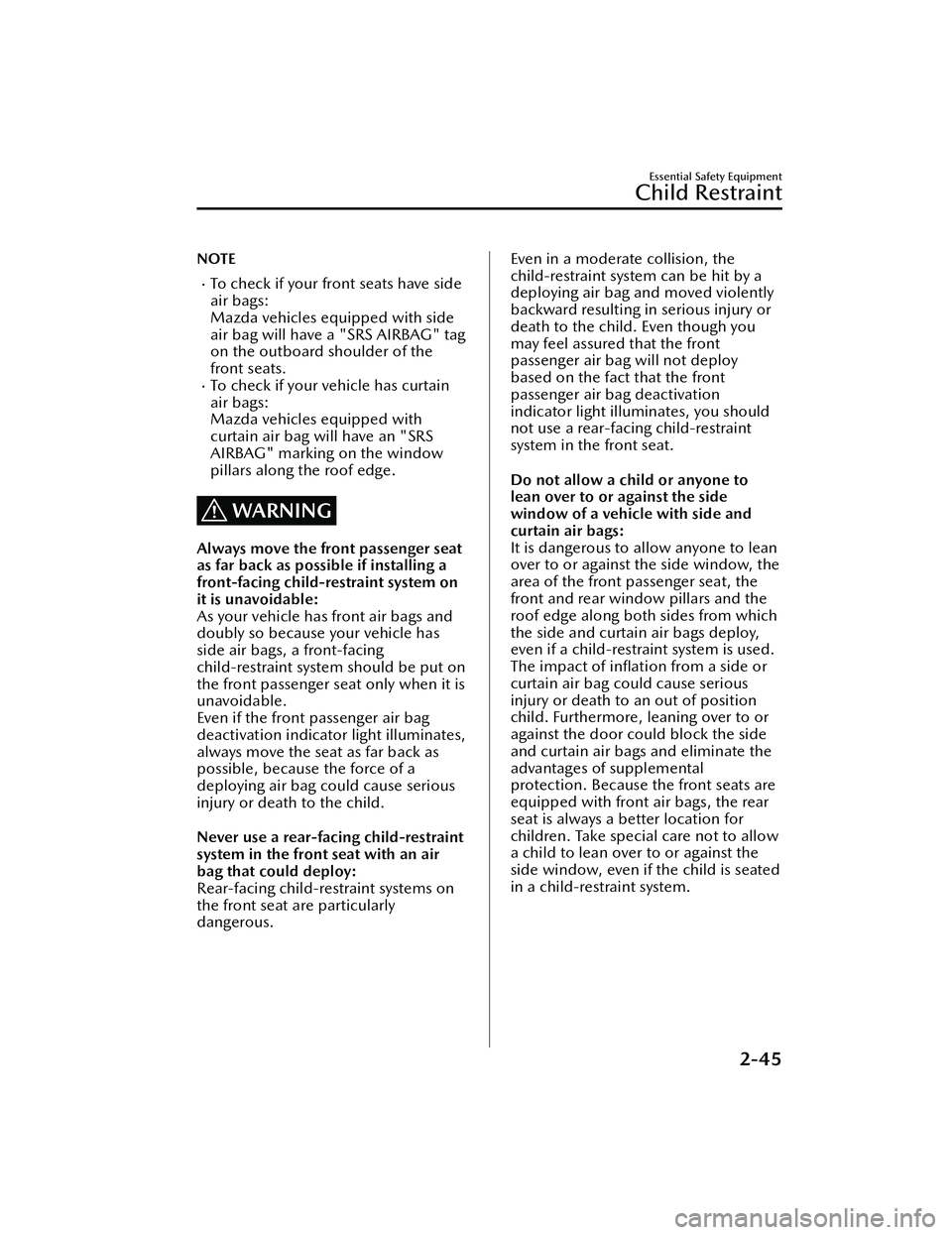
NOTE
To check if your front seats have side
air bags:
Mazda vehicles equipped with side
air bag will have a "SRS AIRBAG" tag
on the outboard shoulder of the
front seats.
To check if your vehicle has curtain
air bags:
Mazda vehicles equipped with
curtain air bag will have an "SRS
AIRBAG" marking on the window
pillars along the roof edge.
WARNING
Always move the front passenger seat
as far back as possible if installing a
front-facing child-restraint system on
it is unavoidable:
As your vehicle has front air bags and
doubly so because your vehicle has
side air bags, a front-facing
child-restraint system should be put on
the front passenger seat only when it is
unavoidable.
Even if the front passenger air bag
deactivation indicator light illuminates,
always move the seat as far back as
possible, because the force of a
deploying air bag could cause serious
injury or death to the child.
Never use a rear-facing child-restraint
system in the front seat with an air
bag that could deploy:
Rear-facing child-restraint systems on
the front seat are particularly
dangerous.
Even in a moderate collision, the
child-restraint system can be hit by a
deploying air bag and moved violently
backward resulting in serious injury or
death to the child. Even though you
may feel assured that the front
passenger air bag will not deploy
based on the fact that the front
passenger air bag deactivation
indicator light illuminates, you should
not use a rear-facing child-restraint
system in the front seat.
Do not allow a child or anyone to
lean over to or against the side
window of a vehicle with side and
curtain air bags:
It is dangerous to allow anyone to lean
over to or against the side window, the
area of the front passenger seat, the
front and rear window pillars and the
roof edge along both sides from which
the side and curtain air bags deploy,
even if a child-restraint system is used.
The impact of inflation from a side or
curtain air bag could cause serious
injury or death to an out of position
child. Furthermore, leaning over to or
against the door could block the side
and curtain air bags and eliminate the
advantages of supplemental
protection. Because the front seats are
equipped with fron t air bags, the rear
seat is always a better location for
children. Take special care not to allow
a child to lean over to or against the
side window, even if the child is seated
in a child-restraint system.
Essential Safety Equipment
Child Restraint
2-45
MX -30_8JD4-EA -21G_Edition2_new 2021-5-18 14:38:07
Page 64 of 547

8. Switch the power switch ON andmake sure the front passenger air
bag deactivation indicator light
illuminates after installing a
child-restraint system on the front
passenger seat.
If the front passenger air bag
deactivation indicator light does
not illuminate, remove the
child-restraint system, switch the
power switch to OFF, and then
re-install the child-restraint system
(page 2-64).
WARNING
Do not seat a child in a child-restraint
system on the front passenger seat if
the front passenger air bag
deactivation indicator light does not
illuminate:
While it is always better to install any
child-restraint system on the rear seat,
it is imperative that a child-restraint
system ONLY be used on the front
passenger seat if the deactivation
indicator light illuminates when the
child is seated in the child-restraint
system (page 2-64). Seating a child in
a child-restraint system installed on the
front passenger seat with the front
passenger air bag deactivation
indicator light not illuminated is
dangerous. If this indicator light does
not illuminate, this means that the
front passenger front and side air bags,
and knee air bags, and seat belt
pretensioners are ready for
deployment. If an accident were to
deploy an air bag , a child in a
child-restraint system sitting in the
front passenger seat could be seriously
injured or killed. If the indicator light
does not illuminate after seating a
child in a child-restraint system on the
front passenger seat, seat a child in a
child-restraint system on the rear seat
and consult an Authorized Mazda
Dealer as soon as possible.
▼ Using LATCH Lower Anchor
Your Mazda is equipped with LATCH
lower anchors for attachment of
specially designed LATCH
child-restraint systems in the rear seats.
Both anchors must be used, otherwise
the seat will bounce around and put
the child in danger. Most LATCH
child-restraint systems must also be
used in conjunction with a tether to be
e
ff ective. If they have a tether you must
use it to better assure your child's
safety.
Essential Safety Equipment
Child Restraint
2-47
MX -30_8JD4-EA -21G_Edition2_new 2021-5-18 14:38:07
Page 69 of 547
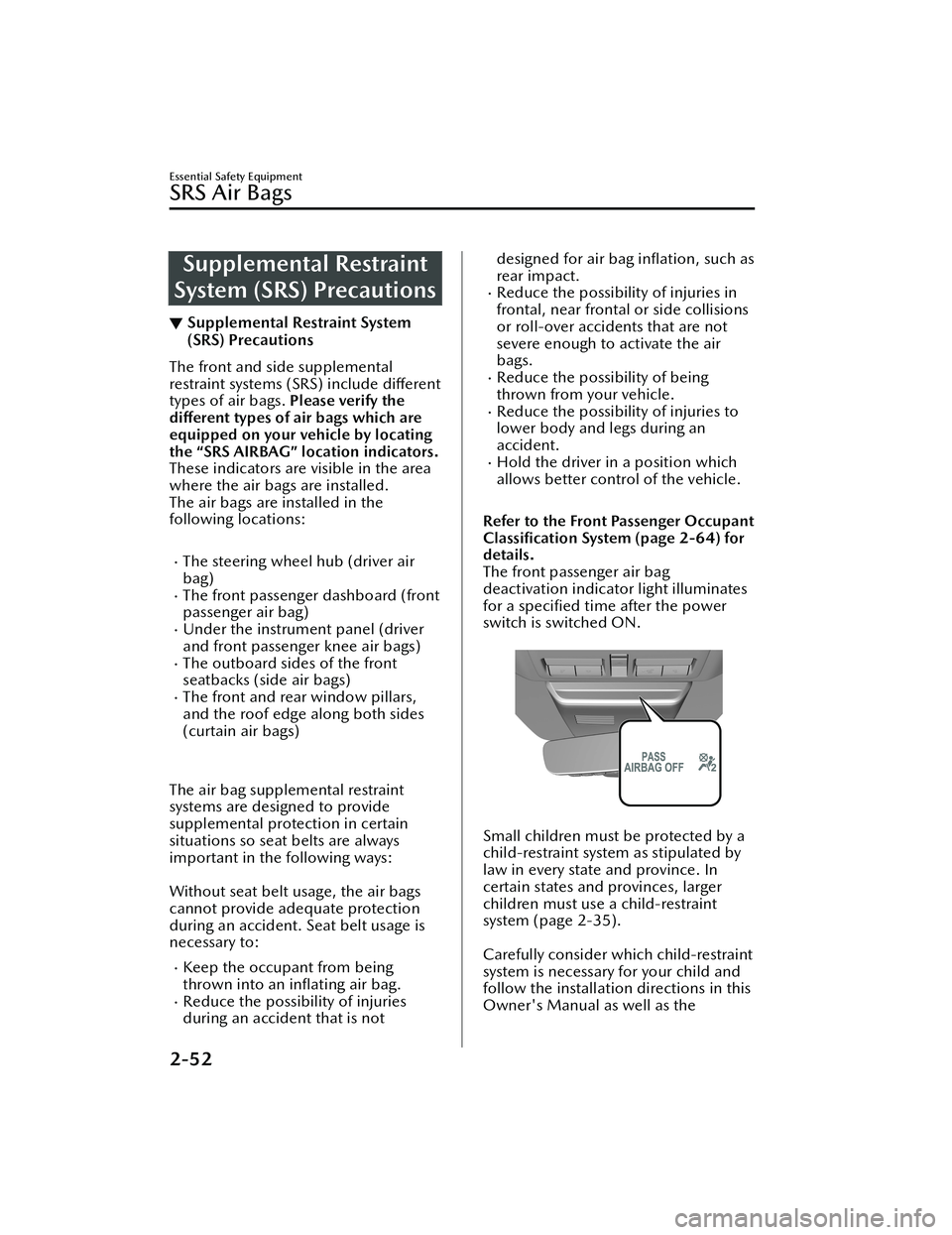
Supplemental Restraint
System (SRS) Precautions
▼ Supplemental Restraint System
(SRS) Precautions
The front and side supplemental
restraint systems (SRS) include
different
types of air bags. Please verify the
di fferent types of air bags which are
equipped on your vehicle by locating
the “SRS AIRBAG” location indicators.
These indicators are visible in the area
where the air bags are installed.
The air bags are installed in the
following locations:
The steering wheel hub (driver air
bag)
The front passenger dashboard (front
passenger air bag)
Under the instrument panel (driver
and front passenger knee air bags)
The outboard sides of the front
seatbacks (side air bags)
The front and rear window pillars,
and the roof edge along both sides
(curtain air bags)
The air bag supplemental restraint
systems are designed to provide
supplemental protection in certain
situations so seat belts are always
important in the following ways:
Without seat belt usage, the air bags
cannot provide adequate protection
during an accident. Seat belt usage is
necessary to:
Keep the occupant from being
thrown into an inflating air bag.
Reduce the possibility of injuries
during an accident that is not
designed for air bag in
flation, such as
rear impact.
Reduce the possibility of injuries in
frontal, near frontal or side collisions
or roll-over accidents that are not
severe enough to activate the air
bags.
Reduce the possibility of being
thrown from your vehicle.
Reduce the possibility of injuries to
lower body and legs during an
accident.
Hold the driver in a position which
allows better control of the vehicle.
Refer to the Front Passenger Occupant
Classi fication System (page 2-64) for
details.
The front passenger air bag
deactivation indicator light illuminates
for a speci fied time after the power
switch is switched ON.
Small children must be protected by a
child-restraint system as stipulated by
law in every state and province. In
certain states and provinces, larger
children must use a child-restraint
system (page 2-35).
Carefully consider which child-restraint
system is necessary for your child and
follow the installation directions in this
Owner's Manual as well as the
Essential Safety Equipment
SRS Air Bags
2-52
MX -30_8JD4-EA -21G_Edition2_new 2021-5-18 14:38:07
Page 70 of 547

child-restraint system manufacturer's
instructions.
WARNING
Seat belts must be worn in air bag
equipped vehicles:
Depending only on the air bags for
protection during an accident is
dangerous. Alone, air bags may not
prevent serious injuries. The
appropriate air bags can be expected
to inflate only in the first accident, such
as frontal, near frontal or side collisions
or roll-over accidents that are at least
moderate. Vehicle occupants should
always wear seat belts.
Children should not ride in the front
passenger seat:
Placing a child, 12 years or under, in
the front seat is dangerous. The child
could be hit by a deploying air bag and
be seriously injured or even killed. A
sleeping child is more likely to lean
against the door and be hit by the side
air bag in moderate collision to the
front-passenger side of the vehicle.
Whenever possible, always secure a
child 12 years and under on the rear
seats with an appropriate
child-restraint system for the child's
age and size.
Never use a rear-facing child-restraint
system in the front seat with an air
bag that could deploy:
Rear-facing child-restraint systems on
the front seat are particularly
dangerous even though you may feel
assured that a front passenger air bag
will not deploy based on the fact that
the front passenger air bag
deactivation indicator light illuminates.
The child-restraint system can be hit by
a deploying air bag and moved
violently backward resulting in serious
injury or death to the child.
Do not sit too close to the driver and
front passenger air bags:
Sitting too close to the driver and front
passenger air bag modules or placing
hands or feet on them is extremely
dangerous. The driver and front
passenger air bags inflate with great
force and speed. Serious injuries could
occur if someone is too close. The
driver should always hold onto only the
rim of the steering wheel. The front
seat passenger should keep both feet
on the floor. Front seat occupants
should adjust their seats as far back as
possible and always sit upright against
the seatbacks with seat belts worn
properly.
Essential Safety Equipment
SRS Air Bags
2-53
MX -30_8JD4-EA -21G_Edition2_new 2021-5-18 14:38:07
Page 73 of 547
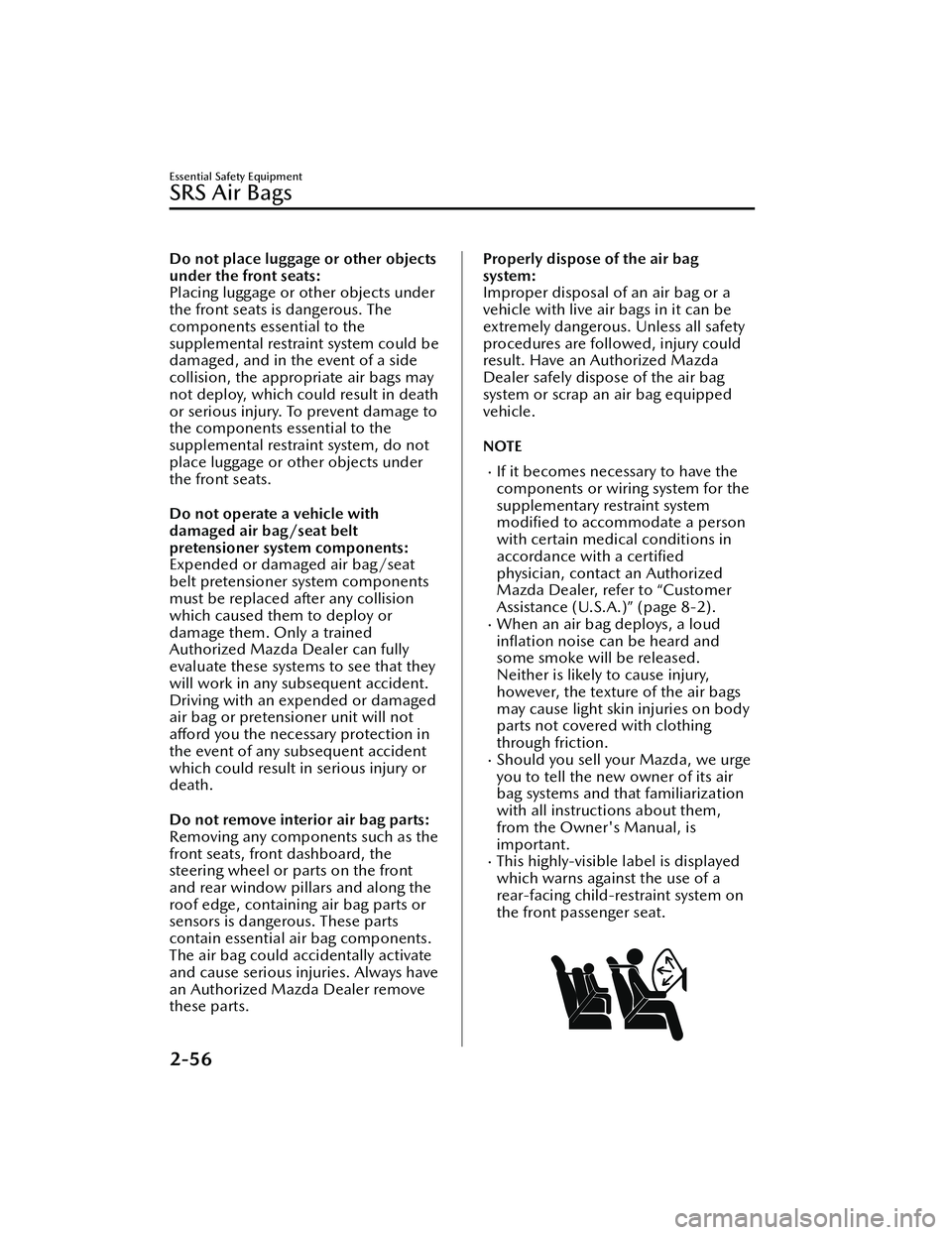
Do not place luggage or other objects
under the front seats:
Placing luggage or other objects under
the front seats is dangerous. The
components essential to the
supplemental restraint system could be
damaged, and in the event of a side
collision, the appropriate air bags may
not deploy, which could result in death
or serious injury. To prevent damage to
the components essential to the
supplemental restraint system, do not
place luggage or other objects under
the front seats.
Do not operate a vehicle with
damaged air bag/seat belt
pretensioner system components:
Expended or damaged air bag/seat
belt pretensioner system components
must be replaced after any collision
which caused them to deploy or
damage them. Only a trained
Authorized Mazda Dealer can fully
evaluate these systems to see that they
will work in any subsequent accident.
Driving with an expended or damaged
air bag or pretensioner unit will not
aff ord you the necessary protection in
the event of any subsequent accident
which could result in serious injury or
death.
Do not remove interior air bag parts:
Removing any components such as the
front seats, front dashboard, the
steering wheel or parts on the front
and rear window pillars and along the
roof edge, containing air bag parts or
sensors is dangerous. These parts
contain essential air bag components.
The air bag could accidentally activate
and cause serious injuries. Always have
an Authorized Mazda Dealer remove
these parts.Properly dispose of the air bag
system:
Improper disposal of an air bag or a
vehicle with live air bags in it can be
extremely dangerous. Unless all safety
procedures are followed, injury could
result. Have an Authorized Mazda
Dealer safely dispose of the air bag
system or scrap an air bag equipped
vehicle.
NOTE
If it becomes necessary to have the
components or wiring system for the
supplementary restraint system modi fied to accommodate a person
with certain medical conditions in
accordance with a certi fied
physician, contact an Authorized
Mazda Dealer, refer to “Customer
Assistance (U.S.A.)” (page 8-2).
When an air bag deploys, a loud in flation noise can be heard and
some smoke will be released.
Neither is likely to cause injury,
however, the texture of the air bags
may cause light skin injuries on body
parts not covered with clothing
through friction.
Should you sell your Mazda, we urge
you to tell the new owner of its air
bag systems and that familiarization
with all instructions about them,
from the Owner's Manual, is
important.
This highly-visible label is displayed
which warns against the use of a
rear-facing child-restraint system on
the front passenger seat.
Essential Safety Equipment
SRS Air Bags
2-56
MX -30_8JD4-EA -21G_Edition2_new 2021-5-18 14:38:07
Page 74 of 547

Supplemental Restraint System Components
▼Supplemental Restraint System Components
1. Side and curtain in
flators and air bags
2. Side crash sensors
3. Roll-over sensor, crash sensors, and diagnostic module (SAS unit)
4. Driver/Front passenger in flators and air bags
5. Air bag/front seat belt pretensioner system warning indication/warning light (page 7-27)
6. Driver/Front passenger knee in flators and air bags
7. Front passenger air bag deactivation indicator light (page 2-64)
8. Front air bag sensors
9. Seat belt pretensioners (page 2-31)
10.Front passenger seat we ight sensors (page 2-64)
11.Front passenger seat weight sensor control module
12.Driver and front passenger seat belt buckle switches (page 2-68)
13.Driver seat slide position sensor (page 2-64)
Essential Safety Equipment
SRS Air Bags
2-57
MX -30_8JD4-EA -21G_Edition2_new 2021-5-18 14:38:07
Page 77 of 547
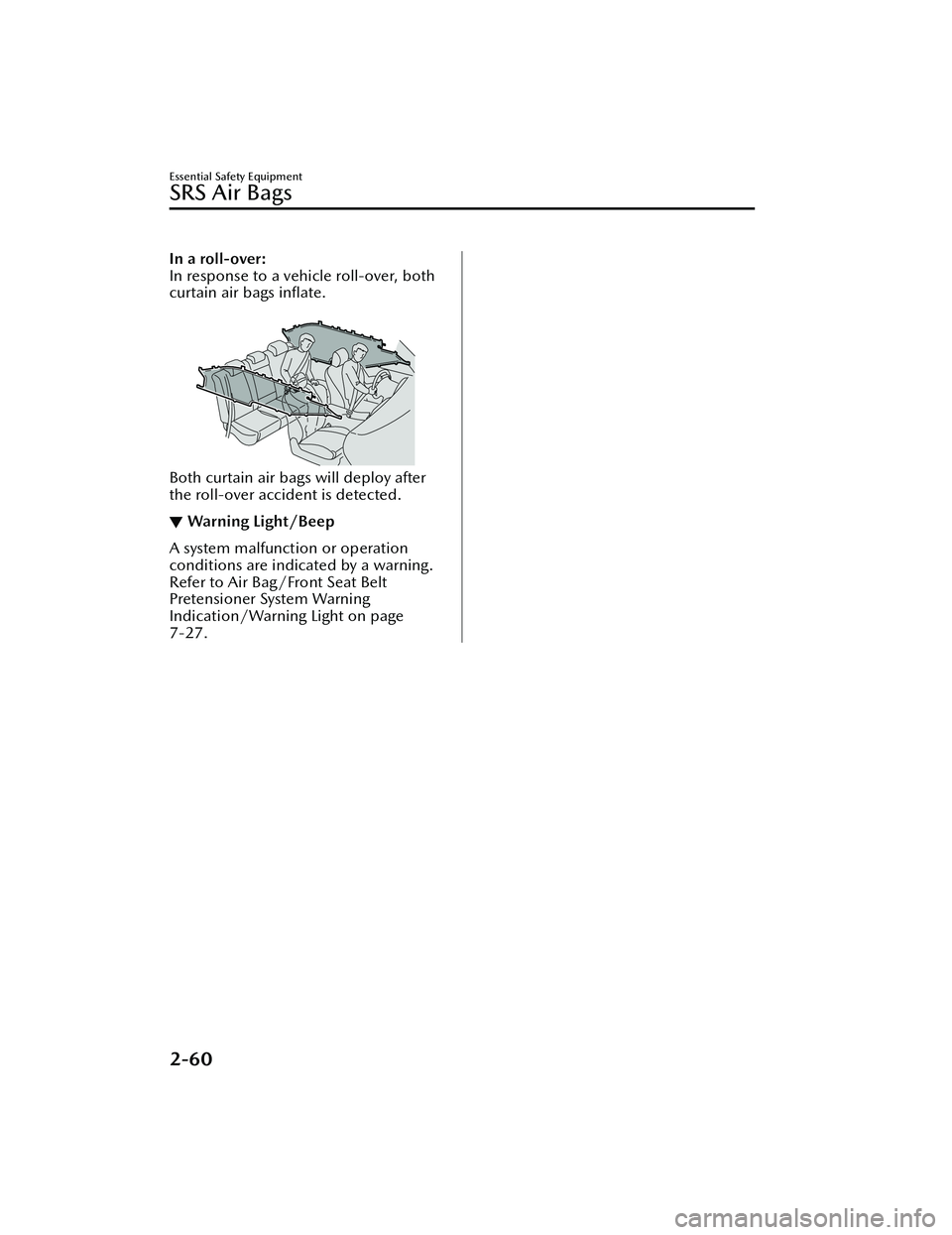
In a roll-over:
In response to a vehicle roll-over, both
curtain air bags inflate.
Both curtain air bags will deploy after
the roll-over accident is detected.
▼ Warning Light/Beep
A system malfunction or operation
conditions are indicated by a warning.
Refer to Air Bag/Front Seat Belt
Pretensioner System Warning
Indication/Warning Light on page
7-27.
Essential Safety Equipment
SRS Air Bags
2-60
MX
-30_8JD4-EA -21G_Edition2_new 2021-5-18 14:38:07
Page 81 of 547

not be detected as severe enough to
deploy the SRS air bag equipment.
Side impacts involving trees or poles
Side impacts with two-wheeled
vehicles
Limitations to roll-over detection:
The following illustration is an example
of an accident that may not be
detected as a roll-over accident.
Therefore, the front seat belt
pretensioners and curtain air bags may
not deploy.
Pitch end over end
Driver and Front
Pa s s e n g e r O cc u p a n t
Classi fication System
▼Driver and Front Passenger
Occupant
Classification System
First, please read "Supplemental
Restraint System (SRS) Precautions"
(page 2-52) carefully.
▼Driver Seat Slide Position Sensor
Your vehicle is equipped with a driver
seat slide position sensor as a part of
the supplemental restraint system. The
sensor is located under the driver seat.
The sensor determines whether the
driver seat is fore or aft of a reference
position and sends the seat position to
the diagnostic module (SAS unit).
The SAS unit is designed to control the
deployment of the driver air bag
depending on how close the driver
seat is to the steering wheel.
The air bag/front seat belt
pretensioner system warning light
fl
ashes if the sensor has a possible
malfunction (page 2-60).
▼ Front Passenger Seat Weight
Sensors
Your vehicle is equipped with a front
passenger seat weight
sensors as a part
of the supplemental restraint system.
These sensors are located under both
of the front passenger seat rails. These
sensors determine the total seated
weight on the front passenger seat and
monitor the seat belt buckle for the
front passenger seat. The SAS unit is
designed to prevent the front
passenger front and side air bags and
knee air bags, and seat belt
pretensioner system from deploying if
Essential Safety Equipment
SRS Air Bags
2-64
MX -30_8JD4-EA -21G_Edition2_new 2021-5-18 14:38:07
Page 82 of 547
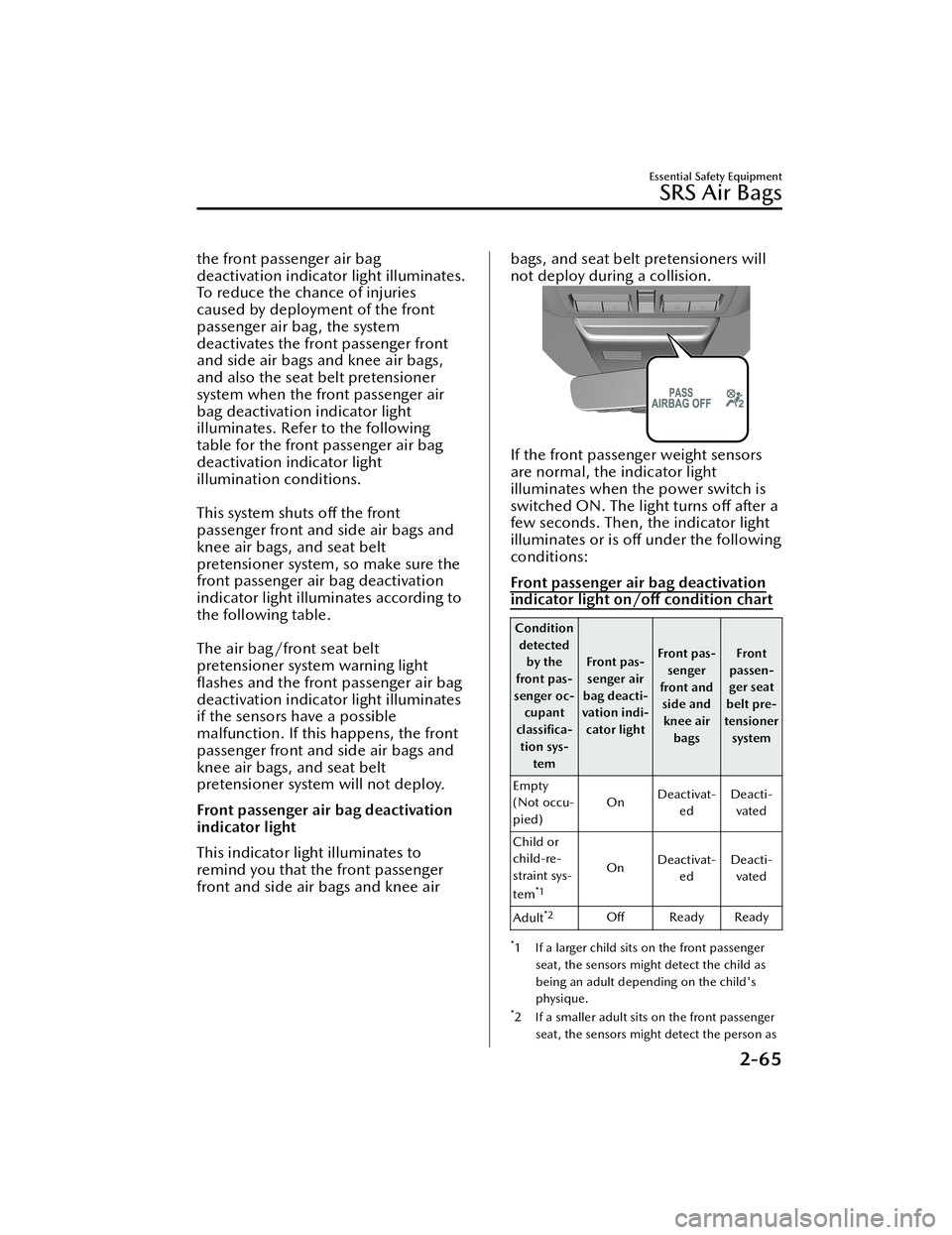
the front passenger air bag
deactivation indicator light illuminates.
To reduce the chance of injuries
caused by deployment of the front
passenger air bag, the system
deactivates the front passenger front
and side air bags and knee air bags,
and also the seat belt pretensioner
system when the front passenger air
bag deactivation indicator light
illuminates. Refer to the following
table for the front passenger air bag
deactivation indicator light
illumination conditions.
This system shuts off the front
passenger front and side air bags and
knee air bags, and seat belt
pretensioner system, so make sure the
front passenger air bag deactivation
indicator light illuminates according to
the following table.
The air bag/front seat belt
pretensioner system warning light
fl ashes and the front passenger air bag
deactivation indicator light illuminates
if the sensors have a possible
malfunction. If this happens, the front
passenger front and side air bags and
knee air bags, and seat belt
pretensioner system will not deploy.
Front passenger air bag deactivation
indicator light
This indicator light illuminates to
remind you that the front passenger
front and side air bags and knee airbags, and seat belt pretensioners will
not deploy during a collision.
If the front passenger weight sensors
are normal, the indicator light
illuminates when the power switch is
switched ON. The light turns off after a
few seconds. Then, the indicator light
illuminates or is o ff under the following
conditions:
Front passenger air bag deactivation
indicator light on/off condition chart
Condition
detected by the
front pas-
senger oc- cupant
classifi ca-
tion sys- tem Front pas-
senger air
bag deacti-
vation indi- cator light Front pas-
senger
front and side andknee air bags Front
passen-
ger seat
belt pre-
tensioner system
Empty
(Not occu-
pied) On
Deactivat-
ed Deacti-
vated
Child or
child-re-
straint sys-
tem
*1
On Deactivat-
ed Deacti-
vated
Adult
*2Off Ready Ready
*1 If a larger child sits on the front passenger
seat, the sensors might detect the child as
being an adult depending on the child's
physique.
*2 If a smaller adult sits on the front passenger
seat, the sensors might detect the person as
Essential Safety Equipment
SRS Air Bags
2-65
MX-30_8JD4-EA -21G_Edition2_new 2021-5-18 14:38:07
Page 83 of 547

being a child depending on the person's
physique.
The curtain air bag is ready for in flating
regardless of what the front passenger air bag
deactivation indicator light on/o ff condition
chart indicates.
If the front passenger air bag
deactivation indicator light does not
illuminate when the power switch is
switched ON and does not illuminate
as indicated in the front passenger air
bag deactivation indicator light on/o ff
condition chart, do not allow a child to
sit in the front passenger seat and
consult an Authorized Mazda Dealer
as soon as possible. The system may
not work properly in an accident.
WARNING
Do not decrease the total seated
weight on the front passenger seat:
When an adult or large child sits on the
front passenger seat, decreasing the
total seated weight on the front
passenger seat required for air bag
deployment is dangerous. The front
passenger seat weight sensors will
detect the reduced total seated weight
condition and the front passenger front
and side air bags and knee air bags,
and the seat belt pretensioner system
will not deploy during an accident. The
front passenger will not have the
supplementary protection of the air
bag , which could result in serious
injury. Decreasing the total seated
weight on the front passenger seat
could result in an air bag not deploying
under the following conditions, for
example:
A front passenger is seated as shown
in the following figure:
A rear passenger pushes up on the
front passenger seat with their feet.
Essential Safety Equipment
SRS Air Bags
2-66
MX -30_8JD4-EA -21G_Edition2_new 2021-5-18 14:38:07